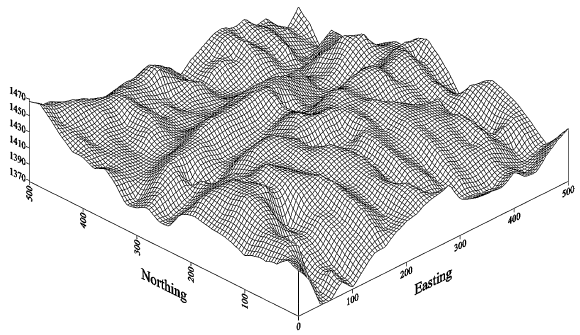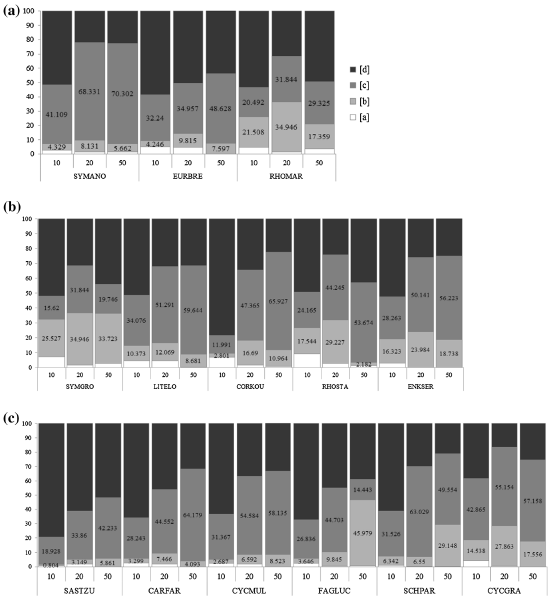
Researchers Disentangle Topography and Space Contribution on Dominant Species Distributions in BDGS
Jul 31, 2014 Email"> PrintText Size

Topography and space are two important factors determining plant species assemblages in forest communities. Quantification of the contribution of these two factors in determining species distribution helps us to evaluate their relative importance in determining species assemblages.
PhD student WANG Qinggang, supervised by Prof. JIANG Mingxi from Wuhan Botanical Garden, disentangled the relative contribution of topography and space in determining the distributions of 14 dominant species across life stages and sampling scales in the 25-hm2 Badagongshan Forest Dynamic plot.
Correlation analyses and torus-translation tests showed species abundance was mostly correlated with topographic wetness index, vertical distance from the channel network and convexity. Variation partitioning showed that pure topography, pure space and spatially structured topography explained about 2.1 %, 41.2 % and 13.8 % of the variation in species distributions, respectively. For nine species, total topography fractions peaked in 20 m quadrats. For ten species, the pure space fractions peaked in 50 m quadrats. For many species, the total topography fraction and the pure space fraction were larger for the most abundant lifestages, which reflected the importance of sampling effect. However, some cases did not follow this trend suggesting that the effects of ecological processes such as habitat filtering, density dependence or dispersal limitation may exceed the sampling effects.
In conclusion, they found that spatially structured topography and pure space primarily shaped the distribution of dominant tree species. Furthermore, their effects were both scale- and life stage-dependent.
Relevant results were published in Chinese Science Bulletin entitled “Disentangling the effects of topography and space on the distributions of dominant species in a subtropical forest”. This work was supported by the National Natural Science Foundation of China and the Chinese Forest Biodiversity Monitoring Network.

Topographic map of 25-ha Badagongshan Forest Dynamic Plot, central China (Image by WANG Qinggang)

Variation partioning results of the 14 dominant species for three life forms: (a) shrub, (b)understorey and (c) canopy at three different sampling quadrat sizes (10, 20 and 50 m) in Badagongshan Forest Dynamic Plot, central China. [a] pure topography; [b] spatially structured topography; [c] pure space; [d] unexplained variacce (Image by WANG Qinggang)
Topography and space are two important factors determining plant species assemblages in forest communities. Quantification of the contribution of these two factors in determining species distribution helps us to evaluate their relative importance in determining species assemblages.
PhD student WANG Qinggang, supervised by Prof. JIANG Mingxi from Wuhan Botanical Garden, disentangled the relative contribution of topography and space in determining the distributions of 14 dominant species across life stages and sampling scales in the 25-hm2 Badagongshan Forest Dynamic plot.
Correlation analyses and torus-translation tests showed species abundance was mostly correlated with topographic wetness index, vertical distance from the channel network and convexity. Variation partitioning showed that pure topography, pure space and spatially structured topography explained about 2.1 %, 41.2 % and 13.8 % of the variation in species distributions, respectively. For nine species, total topography fractions peaked in 20 m quadrats. For ten species, the pure space fractions peaked in 50 m quadrats. For many species, the total topography fraction and the pure space fraction were larger for the most abundant lifestages, which reflected the importance of sampling effect. However, some cases did not follow this trend suggesting that the effects of ecological processes such as habitat filtering, density dependence or dispersal limitation may exceed the sampling effects.
In conclusion, they found that spatially structured topography and pure space primarily shaped the distribution of dominant tree species. Furthermore, their effects were both scale- and life stage-dependent.
Relevant results were published in Chinese Science Bulletin entitled “Disentangling the effects of topography and space on the distributions of dominant species in a subtropical forest”. This work was supported by the National Natural Science Foundation of China and the Chinese Forest Biodiversity Monitoring Network.

Topographic map of 25-ha Badagongshan Forest Dynamic Plot, central China (Image by WANG Qinggang)

Variation partioning results of the 14 dominant species for three life forms: (a) shrub, (b)understorey and (c) canopy at three different sampling quadrat sizes (10, 20 and 50 m) in Badagongshan Forest Dynamic Plot, central China. [a] pure topography; [b] spatially structured topography; [c] pure space; [d] unexplained variacce (Image by WANG Qinggang)
CAS Institutes
There are 124 Institutions directly under the CAS by the end of 2012, with 104 research institutes, five universities & supporting organizations, 12 management organizations that consist of the headquarters and branches, and three other units. Moreover, there are 25 legal entities affiliated and 22 CAS invested holding enterprisesThere are 124 I...>> more
Contact Us

Chinese Academy of Sciences
Add: 52 Sanlihe Rd., Xicheng District, Beijing, China
Postcode: 100864
Tel: 86-10-68597592 (day) 86-10-68597289 (night)
Fax: 86-10-68511095 (day) 86-10-68512458 (night)
E-mail: cas_en@cas.cn

